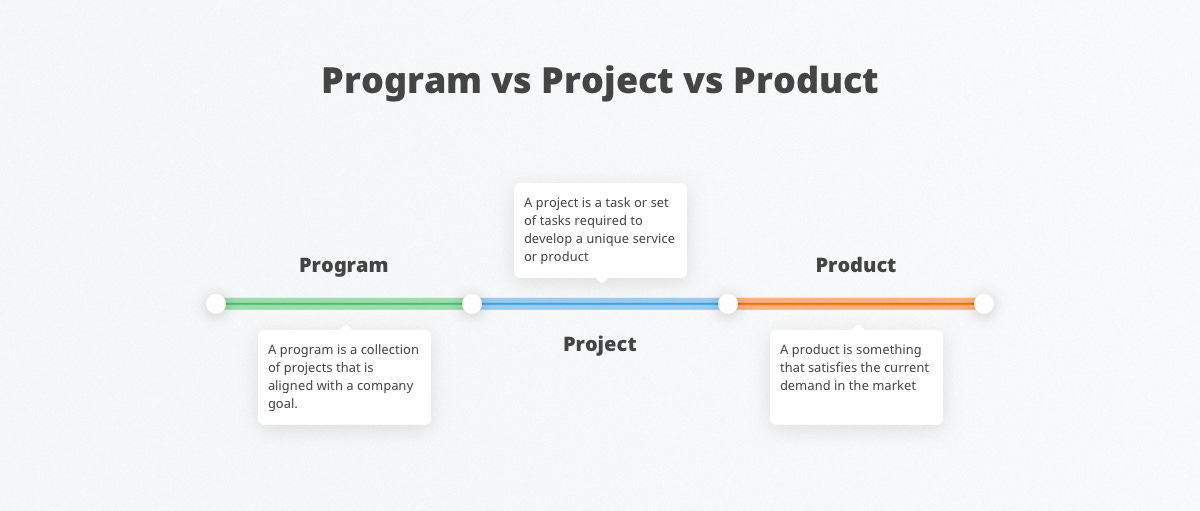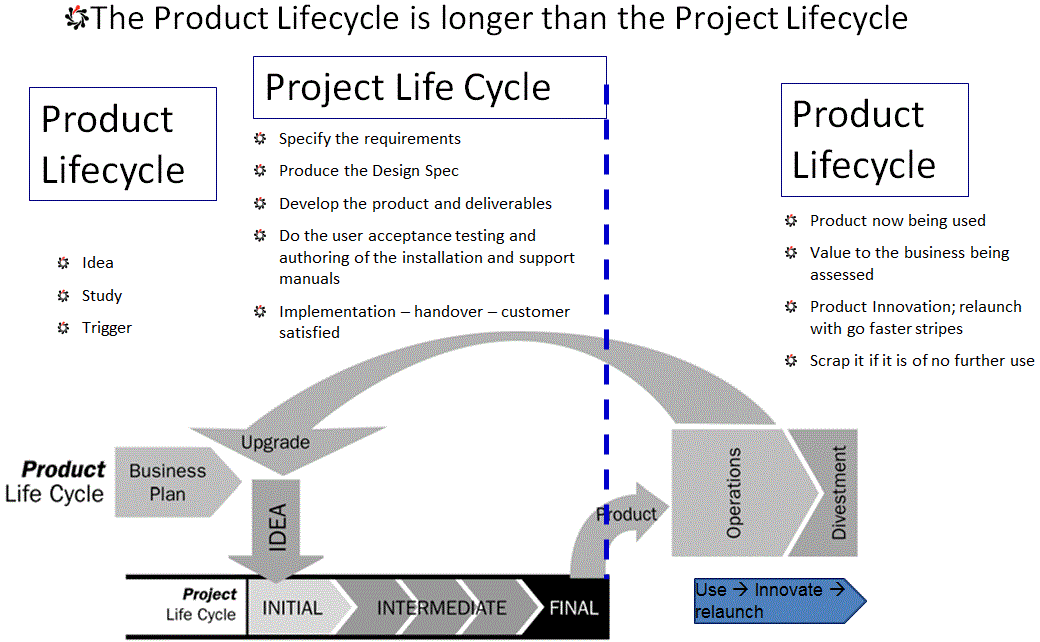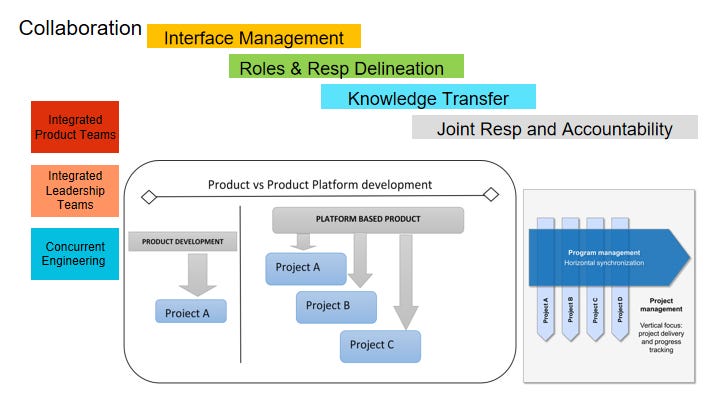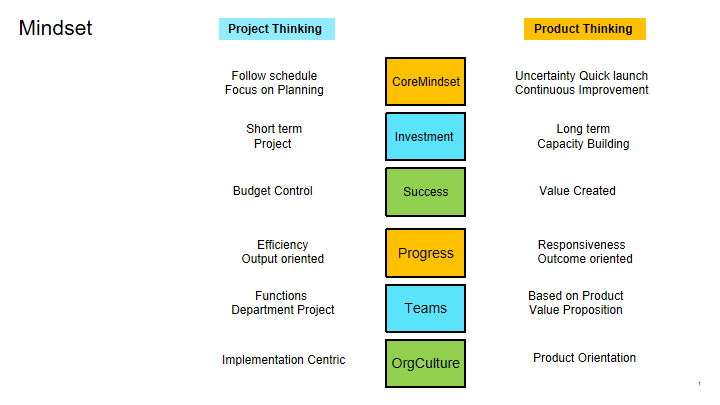
Project and Product management are two disciplines that are well-developed in their application and practice. Both are crucial and required in the development of products and services in business and industry. While there are plenty of similarities between the two, there are differences too in terms of content, emphasis and approach. Some key questions:
The two disciplines, should they be practiced in combination or separately?
What can we do to improve the learnings and sharing of best practices between the two disciplines?
A clearer understanding of the interface between project and product management will be helpful in getting the best output from the two disciplines.
Project & Product Management
Let’s look at some definitions 1 to get a better understanding
Project Management: A project is temporary in that it has a defined beginning and end in time, and therefore defined scope and resources. It, is the application of knowledge, skills, tools, and techniques to project activities to meet the project requirements
Program Management: Programs comprise different projects that are interconnected and are also part of the long-term business objectives. The Program Manager leads the program strategy, objectives, and assesses the business impact.
Product Management: You can define a product as anything that can be offered in the market to solve a problem or satisfy a need. It varies from a service or software to a physical product. It includes responsibilities like planning, research, forecasting, and production.
Life Cycles
The product life cycle starts with the concept and goes through stages development growth and decline. It involves introducing it in the market and suitably modifying or adding features when there is a decline to ensure the product remains but at some point it may be phased out . It can be seen as a cradle to grave kind of situation .
The project life cycle is part of product life cycle and is limited to the phase where the product is developed and is shorter as compared to the product life cycle. The project life cycle is supported through project management processes.
The program management life cycle is someway similar to the product management life cycle in terms of product development. Iti s longer than the project life cycle and has its focus more on the business areas of the organization. The difference between program and product management life cycles is that the former is more delivery focused whereas the latter is more market oriented in its approach. This can easily be seen in platform development which is used considerably when multiple products are being developed in an organization over a period.
Commonalities & Conflicts
As we can see there are plenty of Commonalities in the roles performed by the project manager and the product manager.
Dealing with stakeholders, communicating with them and providing the right leadership most often without power. In addition, prioritizing among various alternatives for decision making, having strong industry knowledge and using team to get things done. All these are the roles common to both the disciplines.
However, the focus is different for the two areas. For product management it is strategy, market and a long-term view and for project management it is more tactical, delivery oriented and short-term in line with the project.
Where are the Conflicts?
When the roles of product and project/program manager are performed by the same person, it is obvious that there would be no conflicts as s(he) is able to adjust and balance between the roles. The problem arises when two different people take on these roles as it would be necessary when an organization grows or is a large organization. The question is Who will do what? and if this is not clearly understood or laid out, it could be quite a challenge. e.g., Meeting with stakeholders or customers, whose responsibility? Roadmap, who is in charge? product or program manager? What about team communication?
In some situations, the project manager is senior to the product manager particularly if it is a program manager. In such a case, the conflicts take on a different dimension, with communication and roles and responsibilities.
In some industries the job description of a program manager is a senior product manager and responsible for a platform of products. At times, the designation one single project with a single product.
So, the nomenclature, job description and levels of product and project /program managers makes the conflicts between them more complex and challenging.
So, what is the way out for the conflicts and the challenges? Collaboration is the key.
Collaboration
Collaboration between product and implementation teams is not new. Integrated product or leadership teams or concurrent engineering have been in vogue for many decades. But do we apply the concepts in these models when it comes to project/program or product management?
The concept and practice of platforms in product development and its application is on the rise in organizations. This type of structure goes hand in hand with program management. For an effective output and outcome this requires collaboration between the two disciplines.
One area to work on for collaboration between the product and project/program management is of course interface management. This is subject by itself and best practices in inter project collaboration within a program are quite useful here. The other one is delineating, specifying and clarifying the roles and responsibilities for the two disciplines. This part is addressed by focusing on establishing a workable responsibility assignment matrix.
The third way to collaborate between the two is through knowledge transfer. The product manager has to understand and be aware of some project management principles and vice-versa. Project managers need to appreciate product knowledge to ensure that what they deliver is actually in line with strategic objectives and outcomes. Product managers need to do the same with project management to enable delivery of the intended product with its desired features and functions. So there is some amount of knowledge transfer between the two. A key element of the knowledge transfer is the learning by each of the persons in the roles . Frequent awareness programs and refresher courses will be useful here .
The last part of the collaboration effort is Joint responsibility and accountability.
We can think of two situations here. One, when project and product managers are at the same level. This requires joint ownership. Similar management structures exist in small and owner managed companies where both sign on documents. The other case is when roles of product and project management are performed by different people and therefore necessarily, they have to work together to achieve the objectives and outcomes. For this to happen we need interface management, roles and responsibilities delineation and knowledge transfer as prerequisites.
Mindset
The project mindset is task oriented and time dependent. It has short term measures, has a tactical approach and is output oriented. As against this, the product mindset is strategic, customer oriented and looks at a more holistic view. The outlook is inception of the product till the point it is retired. It takes into account business and market conditions.
The mindset is an important factor. It is no good if the product can be produced with the intended value but not on time in the market. Or a product can be delivered on time but does not satisfy the value criteria it is intended to meet. So, both are required product as well project mindset. How can we make it happen? By the 80/20 approach. A product manager needs to use product management for 80% of the time but should include 20% to understand and appreciate project management principles. The reverse should be followed by project managers,80% on project management and 20 % learning product management techniques and processes. This can be done by having an open view and by attending courses and workshops in respective areas.
The mindset factor will be better understood in case of program management, which is managing a group of projects towards an outcome or objective. The mindset of program manager matches well with a product manager because both at the look long-term, at strategic objectives and business outcomes. The difference between the two lies in the program manager having a focus on implementation as against the product manager who gives attention on developing the product.
Concluding
Project (Program) and Product Management have Commonalities. There are many areas of Conflicts between the disciplines. This can be addressed very well through Collaboration.
References
Fernandes,T.The-difference-between-product-program-and-project-management Medium.com Nov 2019
Rao,R.Project Project and Product Management - The Interface www.projectmanagement.com Aug 2021







